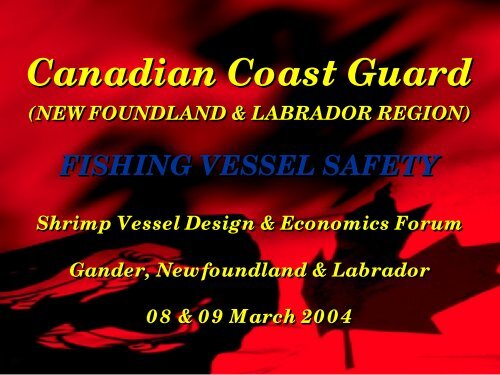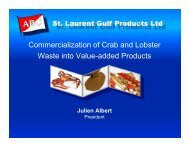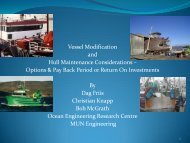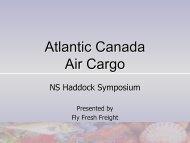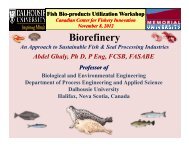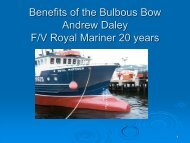Fishing Vessel Safety by Neil Peet/Merv Wiseman - CCFI
Fishing Vessel Safety by Neil Peet/Merv Wiseman - CCFI
Fishing Vessel Safety by Neil Peet/Merv Wiseman - CCFI
You also want an ePaper? Increase the reach of your titles
YUMPU automatically turns print PDFs into web optimized ePapers that Google loves.
Fisheries and Oceans Canada<br />
Canadian Coast Guard<br />
(NEWFOUNDLAND & LABRADOR REGION)<br />
FISHING VESSEL SAFETY<br />
Shrimp <strong>Vessel</strong> Design & Economics Forum<br />
Gander, Newfoundland & Labrador<br />
08 & 09 March 2004<br />
CCG Newfoundland & Labrador Region
Fisheries and Oceans Canada<br />
<strong>Fishing</strong> <strong>Vessel</strong> <strong>Safety</strong><br />
Background<br />
•A A serious trend in the 1990s which indicated<br />
an increasing number of SAR incidents in<br />
fishing vessels < 65 feet in length;<br />
•A A corresponding increase in WHSCC<br />
injuries, incidents and fatalities;<br />
•The evolution of a fishing activity involving<br />
non-traditional species located farther<br />
offshore;<br />
CCG Newfoundland & Labrador Region
Fisheries and Oceans Canada<br />
Background<br />
•Questions of a proper safety regime for<br />
small fishing vessels that included<br />
standards such as education, training,<br />
equipment, seaworthiness, seamanship and<br />
operator competency;<br />
•An issue of regulatory enforcement<br />
protocols (mandatory or voluntary),<br />
particularly for vessels < 15 GRT;<br />
•DFO Fish Management issues (vessel<br />
replacement).<br />
CCG Newfoundland & Labrador Region
Fisheries and Oceans Canada<br />
<strong>Fishing</strong> <strong>Vessel</strong> <strong>Safety</strong> Review<br />
•SAR Incidents doubled from 1993 – 1999;<br />
•WHSCC corresponding increase;<br />
•Less fishing effort for the same period<br />
(F/Vs decreased from 13,900 to 9,500);<br />
•SAR incidents occurring further from<br />
shore;<br />
•50 fatalities from 1993 to 2001;<br />
•Highest incident rate in 35 to 45 ft. class;<br />
•Most incidents in crab and ground fish.<br />
CCG Newfoundland & Labrador Region
Fisheries and Oceans Canada<br />
Contributing Factors<br />
•Same infrastructure working further from<br />
shore and prosecuting different species;<br />
•Harsh environmental factors;<br />
•Inadequate training & education regime;<br />
•A willingness <strong>by</strong> fisherpersons to take<br />
risks;<br />
•Improper loading;<br />
•Stability problems related to design<br />
modifications.<br />
CCG Newfoundland & Labrador Region
Fisheries and Oceans Canada<br />
Solutions<br />
• Formation of broad stakeholder group;<br />
• Discussions and consensus on issues;<br />
• Development of a strategic action plan;<br />
• Implementation in progress on:<br />
Education and training;<br />
Regulations and enforcement;<br />
Alerting, Detection and Response;<br />
Fish Management;<br />
Survival (R & D).<br />
CCG Newfoundland & Labrador Region
Fisheries and Oceans Canada<br />
Progress<br />
• Fish Harvesters course developed &<br />
delivered to approximately 8000<br />
fishers;<br />
• New regulations being developed under<br />
Canada Shipping Act reform;<br />
• <strong>Safety</strong> brochure developed &<br />
distributed;<br />
• <strong>Safety</strong> incorporated in integrated Fish<br />
Management (new replacement rules);<br />
• R & D work underway (Man Overboard<br />
Tag & MUN <strong>Safety</strong>Net program).<br />
CCG Newfoundland & Labrador Region
Fisheries and Oceans Canada<br />
FISHING VESSEL SAR STATISTICS<br />
2003<br />
CCG Newfoundland & Labrador Region
Fisheries and Oceans Canada<br />
Total SAR Incidents - 415<br />
• 307 F/V incidents (73.25% of the total<br />
number of incidents);<br />
• 88% of F/V incidents were related to<br />
vessels < 65 feet;<br />
• 71% of F/V incidents were related to<br />
disabled vessels with mechanical<br />
failure, steering, fouled props,<br />
stabilizer problems, etc.<br />
CCG Newfoundland & Labrador Region
Fisheries and Oceans Canada<br />
Percentage of SAR Incidents <strong>by</strong><br />
<strong>Vessel</strong> Class<br />
80%<br />
70%<br />
60%<br />
50%<br />
40%<br />
30%<br />
20%<br />
10%<br />
0%<br />
Commercial <strong>Fishing</strong> Government Other Pleasure<br />
CCG Newfoundland & Labrador Region
Fisheries and Oceans Canada<br />
SAR Incidents <strong>by</strong> Distance From<br />
Shore<br />
42% < 20 nm from shore<br />
20% occurred 20-50 nm<br />
18% occurred 50-100 nm<br />
12% occurred 100-150 nm<br />
CCG Newfoundland & Labrador Region
Fisheries and Oceans Canada<br />
45%<br />
40%<br />
35%<br />
30%<br />
25%<br />
20%<br />
15%<br />
10%<br />
5%<br />
0%<br />
Percentage of <strong>Fishing</strong> <strong>Vessel</strong> SAR<br />
Incidents <strong>by</strong> Distance From Shore<br />
200nm<br />
CCG Newfoundland & Labrador Region
Fisheries and Oceans Canada<br />
SAR Incidents <strong>by</strong> <strong>Vessel</strong> Length<br />
• 8% in vessels < 25 ft.<br />
• 40% in vessels 25 – 35 ft.<br />
• 14% in vessels 35 – 45 ft.<br />
• 26% in vessels 45 – 65 ft.<br />
• 12% in vessels > 65 ft.<br />
88% of all fishing vessel incidents<br />
occurred in vessels < 65 ft.<br />
CCG Newfoundland & Labrador Region
Fisheries and Oceans Canada<br />
SAR Incidents <strong>by</strong> Length of <strong>Vessel</strong><br />
40%<br />
35%<br />
30%<br />
25%<br />
20%<br />
15%<br />
10%<br />
5%<br />
0%<br />
< 25 ft. 25 - 35 ft. 35 - 45 ft. 45 - 65 ft. >65 ft.<br />
CCG Newfoundland & Labrador Region
Fisheries and Oceans Canada<br />
SAR Incidents <strong>by</strong> Species Fished<br />
• 32% Crab Fishery<br />
• 6% Ground Fish<br />
• 24 % Seal Fishery<br />
• 12% Shrimp Fishery<br />
• 02% Lobster Fishery<br />
•8% Cod Fishery<br />
• 16% Other (HERRING, CAPLIN, TUNA, ETC.)<br />
CCG Newfoundland & Labrador Region
Fisheries and Oceans Canada<br />
SAR Incidents <strong>by</strong> Species Fished<br />
35%<br />
30%<br />
25%<br />
20%<br />
15%<br />
10%<br />
5%<br />
0%<br />
Crab<br />
Ground<br />
Fish<br />
Seal Shrimp Lobster Cod Other<br />
CCG Newfoundland & Labrador Region
Fisheries and Oceans Canada<br />
Fatalities & <strong>Vessel</strong> Losses<br />
•No fishing vessel fatalities were recorded in<br />
2003 in Newfoundland & Labrador Region;<br />
•13 fishing vessel fatalities were recorded in<br />
Canada in 2003;<br />
•A total of 5 fishing vessels (< 65 ft.) sank in<br />
Newfoundland & Labrador Region in 2003.<br />
CCG Newfoundland & Labrador Region
Fisheries and Oceans Canada<br />
FISHING VESSEL SAR<br />
INCIDENTS HAVE<br />
CONTINUED TO DECREASE<br />
IN THE NEWFOUNDLAND<br />
AND LABRADOR REGION<br />
SINCE WORK ON FISHING<br />
VESSEL SAFETY<br />
COMMENCED IN 1999.<br />
CCG Newfoundland & Labrador Region
Fisheries and Oceans Canada<br />
450<br />
400<br />
350<br />
300<br />
250<br />
200<br />
150<br />
100<br />
50<br />
0<br />
Number of <strong>Fishing</strong> <strong>Vessel</strong> SAR<br />
Incidents <strong>by</strong> Calendar Year<br />
1993 1994 1995 1996 1997 1998 1999 2000 2001 2002 2003<br />
CCG Newfoundland & Labrador Region
Fisheries and Oceans Canada<br />
<strong>Vessel</strong> <strong>Safety</strong> Design<br />
Considerations<br />
•Harsh environment & distance offshore<br />
(many SAR incidents due to overtaking<br />
weather system on small size vesssels);<br />
•Stable platforms without reliance on<br />
auxiliary tools for stabilization & buoyancy<br />
(SAR incidents due to loss of stabilizers,<br />
defective flume tanks, etc.).<br />
CCG Newfoundland & Labrador Region
Fisheries and Oceans Canada<br />
<strong>Vessel</strong> <strong>Safety</strong> Design<br />
Considerations<br />
•Added detail to safety equipment and<br />
evacuation (safety equipment carriage often<br />
compromised for cargo capacity);<br />
•Adequate space for accommodations and<br />
overall crew comfort (crew fatigue leads to<br />
unsafe seamanship);<br />
•Adequate fuel capacity (many SAR<br />
incidents related to fuel shortages).<br />
CCG Newfoundland & Labrador Region
Fisheries and Oceans Canada<br />
Thank You!<br />
<strong>Neil</strong> <strong>Peet</strong><br />
On Behalf of<br />
<strong>Merv</strong> <strong>Wiseman</strong><br />
OPI – <strong>Fishing</strong> <strong>Vessel</strong> <strong>Safety</strong><br />
Canadian Coast Guard<br />
CCG Newfoundland & Labrador Region


